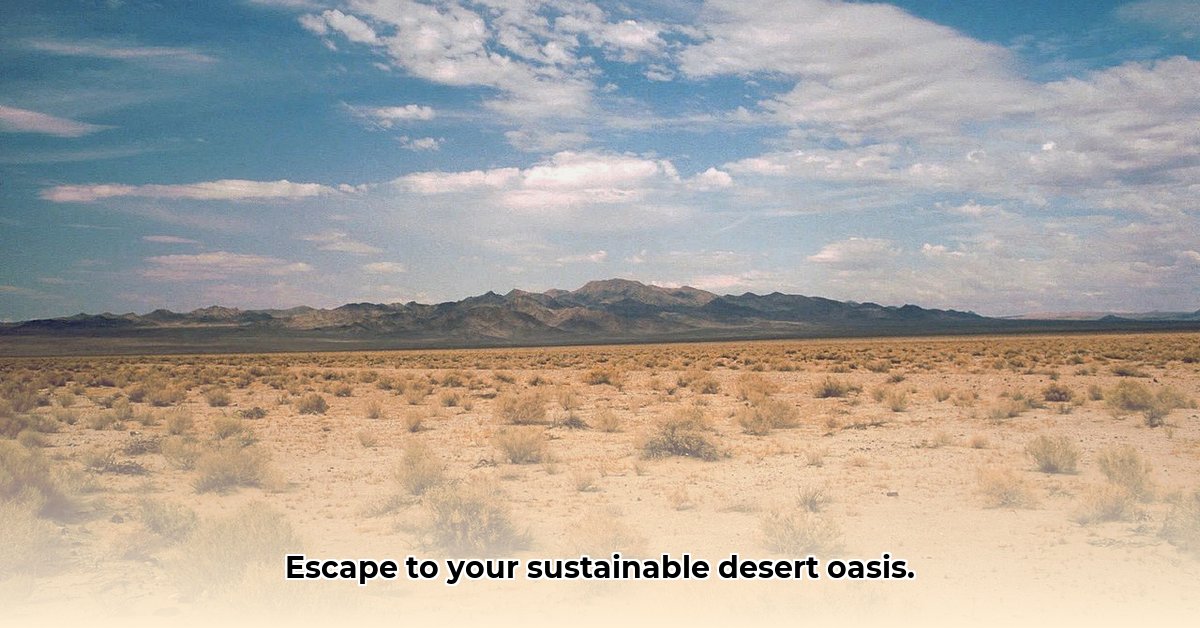Want a gorgeous desert home that’s also eco-friendly? This guide is your roadmap to building a stunning, sustainable desert house. We’ll walk you through everything from choosing the right materials (like adobe and rammed earth!) to optimizing energy use and conserving water. Whether you’re a homeowner, architect, or builder, we’ll give you the practical know-how to create a beautiful, comfortable home that’s kind to the desert environment. For more sustainable home design ideas, check out this guide on small house design. Let’s build a desert oasis that’s both breathtaking and responsible.
Desert-Style House Design: Building Sustainably in Arid Landscapes
Building a home in the desert presents unique challenges, but also incredible opportunities to create a beautiful and sustainable living space. It requires careful consideration of the local climate, resource availability, and environmental impact. Let’s explore designing a desert-style house that’s comfortable, energy-efficient, and environmentally responsible, truly optimizing desert architecture.
Harnessing Passive Design Principles
Forget fighting the desert heat; learn to work with it! Passive design is all about using the natural environment to your advantage. Think of your house as a clever ecosystem, carefully designed to stay comfortable with minimal energy use. This means strategically positioning your home to catch winter sun for warmth and to maximize shade during the summer.
Overhanging roofs, strategically placed trees, and even well-designed walls can drastically reduce the amount of direct sunlight hitting your home during the hottest part of the day – like a natural umbrella! Properly orienting the building on the land with windows on the north and south can also create a more comfortable temperature inside your home. These features can reduce reliance on air conditioning systems.
Effective natural ventilation is also key. Imagine a gentle breeze flowing through strategically placed windows, doors, and vents, creating a natural air conditioning system. Operable windows on opposite sides of a room or building encourage cross-ventilation, which is especially effective in desert climates. It’s amazing how effective this simple approach can be at keeping things cool and reducing your reliance on energy-guzzling AC units.
Finally, using materials with thermal mass – like adobe, rammed earth, or even thick concrete – is like having a giant heat battery. These materials soak up heat during the day and release it slowly at night, keeping your home at a comfortable temperature. Insulating these materials from the outside is vital to keep the heat and cool inside. It’s nature’s own temperature regulator!
Smart Material Choices for a Sustainable Desert Home
The materials you choose are crucial for a truly sustainable desert home. They impact everything from energy consumption to indoor air quality. Adobe, rammed earth, and reclaimed or recycled materials are excellent choices for several reasons. They’re naturally good at regulating temperature, meaning you’ll use less energy for heating and cooling. Plus, using locally sourced materials cuts down on transportation costs and reduces your carbon footprint.
Think about the “embodied energy” – the energy it took to extract, manufacture, and transport a material – when making your decisions. Choosing materials with a lower embodied energy means a smaller environmental impact. Recycled materials are another fantastic option; they minimize waste and are often surprisingly cost-effective. Prioritizing sustainable desert building materials optimizes your eco-friendly construction.
Consider these options:
- Adobe: A traditional building material made from sun-dried earth, adobe offers excellent thermal mass, helping to regulate indoor temperatures.
- Rammed Earth: Constructed by compacting layers of earth, gravel, and clay, rammed earth walls are durable, fire-resistant, and have high thermal mass.
- Straw Bale: Straw bale construction offers excellent insulation, keeping homes cool in summer and warm in winter.
- Reclaimed Wood: Using reclaimed wood reduces deforestation and adds character to your home.
- Recycled Metal: Recycled steel and aluminum can be used for framing, roofing, and other structural elements.
Conserving Water: Every Drop Counts
Water is a precious resource, especially in the desert, so water conservation needs to be a top priority. A truly sustainable desert home incorporates several water-saving strategies. Rainwater harvesting systems collect rainwater from roofs and other surfaces for things like irrigation or toilet flushing, reducing your dependence on municipal water supplies.
Greywater recycling systems reuse wastewater from showers, sinks, and laundry to water your garden – turning waste into a resource! Xeriscaping, using drought-tolerant native plants in your landscaping, dramatically minimizes your watering needs. These aren’t just environmentally sound practices; they can also create a beautiful, low-maintenance landscape you’ll love. These water conservation practices contribute to overall sustainability.
Here are some specific techniques:
- Rainwater Harvesting: Install gutters and storage tanks to collect rainwater for irrigation and other non-potable uses.
- Greywater Recycling: Divert wastewater from showers, sinks, and laundry to irrigate your landscape.
- Xeriscaping: Choose native plants and drought-tolerant groundcovers that require minimal watering.
- Low-Flow Fixtures: Install low-flow toilets, showerheads, and faucets to reduce water consumption inside your home.
- Drip Irrigation: Use drip irrigation systems to deliver water directly to plant roots, minimizing water waste.
Powering Your Desert Oasis with Renewable Energy
While passive design is the foundation of a sustainable desert home, integrating renewable energy sources adds another layer of environmental friendliness. Solar panels are a popular and effective way to generate electricity, using the abundant desert sun. Photovoltaic (PV) panels convert sunlight into electricity, which can power your home and reduce your reliance on the grid. Solar water heaters use sunlight to heat water for domestic use.
In some locations, wind turbines may also be a viable option, depending on wind patterns. However, it’s important to carefully consider the long-term costs, maintenance requirements, and environmental impact of these systems before installing them. Remember, combining renewable energy with a strong passive design foundation is most effective. The ideal solution balances advanced technology with the natural advantages of the desert environment, contributing to sustainable energy solutions.
Building Your Desert Dream: A Step-by-Step Guide
Here’s a practical roadmap to guide you through the process of building your eco-friendly desert home:
- Site Analysis: Before you even think about blueprints, carefully assess your building site. Consider factors like sun path (where the sun travels across the sky), prevailing winds, topography, soil conditions, and local climate conditions. This information is vital for effective passive design.
- Passive Design Strategies: Based on your site analysis, optimize your home’s orientation to maximize winter sun and minimize summer heat. Plan for shading features like overhangs and strategically planted trees, and design for efficient natural ventilation.
- Material Selection: Choose sustainable and locally sourced materials whenever possible. Consider the thermal properties, embodied energy, cost-effectiveness, and aesthetic appeal of each material.
- Water Conservation Plan: Incorporate rainwater harvesting, greywater recycling, and xeriscaping into your plans. Consult with experts to determine the best solutions for your specific needs and local regulations.
- Renewable Energy Integration: Explore solar and wind energy options, carefully evaluating their cost-effectiveness, long-term maintenance requirements, and environmental impact. Consider if these options are the best fit for your project.
- Professional Consultation: Work with architects, builders, and other professionals experienced in sustainable desert home design and construction. Their expertise is invaluable in navigating the complexities of sustainable building practices.
- Permitting and Regulations: Familiarize yourself with local building codes, zoning regulations, and environmental ordinances. Obtain all necessary permits before starting construction.
Learning from the Best: Case Studies
Many inspiring homes around the world beautifully demonstrate the principles of sustainable desert living. Studying successful projects offers valuable insight into practical design choices and problem-solving approaches. Examining both successes and challenges from these projects will help you refine your own design goals. Research projects in your area for the best examples relating to your specific climate and building rules.
Investing in a Sustainable Future: The Long-Term Benefits
Building a sustainable desert home is more than just a construction project; it’s an investment in your future. It’s about creating a comfortable, affordable, and environmentally responsible living space. It’s about choosing a lifestyle that minimizes your environmental impact while maximizing your enjoyment of a beautiful and functional home. This is a long-term commitment to a more sustainable world, increasing environmental consciousness in home design.
How to Compare Lifecycle Costs of Sustainable Desert Home Materials
Building a desert home that’s both beautiful and environmentally responsible requires careful material selection. Understanding lifecycle costs is key to making informed decisions. How to compare lifecycle costs of sustainable desert home materials boils down to a comprehensive analysis, considering factors beyond the initial purchase price.
Passive Design Strategies: The First Step
Before diving into materials, consider passive design. Think of it as harnessing nature’s power to minimize energy needs. Proper home orientation, strategic shading, natural ventilation – these aren’t just buzzwords; they’re the first steps to lowering your energy bills and environmental impact. A well-designed home reduces the burden on costly active systems, reducing the energy consumption in your home.
Sustainable Material Selection: A Balancing Act
Many eco-friendly options exist, each with pros and cons. Let’s explore some popular choices:
- Adobe: This traditional material boasts excellent thermal mass, absorbing heat during the day and releasing it slowly at night, keeping your home comfortable. However, vulnerability to moisture and seismic activity is a significant drawback.
- Rammed Earth: Similar thermal properties to adobe, plus it’s
- Ceramic Tile Backsplash Ideas for Your Kitchen Remodel - December 21, 2025
- Contemporary Kitchen Backsplash Ideas for a Stylish Home - December 20, 2025
- Modern Kitchen Backsplash Ideas To Inspire Your Refresh - December 19, 2025










